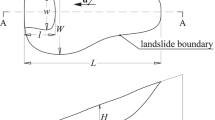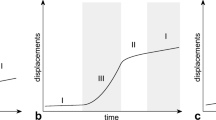Abstract
A framework is proposed to characterize and forecast the displacement trends of slow-moving landslides, defined as the reactivation stage of phenomena in rocks or fine-grained soils, with movements localized along one or several existing shear surfaces. The framework is developed based on a thorough analysis of the scientific literature and with reference to significant reported case studies for which a consistent dataset of continuous displacement measurements is available. Three distinct trends of movement are defined to characterize the kinematic behavior of the active stages of slow-moving landslides in a velocity-time plot: a linear trend-type I, which is appropriate for stationary phenomena; a convex shaped trend-type II, which is associated with rapid increases in pore water pressure due to rainfall, followed by a slow decrease in the groundwater level with time; and a concave shaped trend-type III, which denotes a non-stationary process related to the presence of new boundary conditions such as those associated with the development of a newly formed local slip surface that connects with the main existing slip surface. Within the proposed framework, a model is developed to forecast future displacements for active stages of trend-type II based on displacement measurements at the beginning of the stage. The proposed model is validated by application to two case studies.
Similar content being viewed by others
References
Angeli MG, Gasparetto P, Menotti RM, et al. (1996) A viscoplastic model for slope analysis applied to a mudslide in Cortina d’Ampezzo, Italy. The Quarterly Journal of Engineering Geology 29: 233–240. DOI: 10.1144/GSL.QJEGH.1996.029.P3.06.
Angeli MG, Buma J, Gasparetto P, Pasuto A (1998) A combined hillslope hydrology/stability model for low gradient clay slopes in the Italian Dolomites. Engineering Geology 49: 1–13. DOI: 10.1016/S0013-7952(97)00033-1.
Bertini T, Cugusi F, D’Elia B, Rossi-Doria M (1986) Lenti movimenti di versante nell’Abruzzo adriatico: caratteri e criteri di stabilizzazione, In: Proc. 16 Convegno Nazionale di Geotecnica. Vol 1. Bologna, Italy. pp 91–100. (In Italian)
Bhandari RK (1988) Some practical lessons in the investigation and field monitoring of landslides, In: Proc. 5th International Symposium on Landslides. Vol 3. Lausanne, Switzerland. pp 1435–1457.
Blong RJ (1973) A numerical classification of selected landslides of the debris slide-avalanche-flow type. Engineering Geology 7: 99–144. DOI: 10.1016/0013-7952(73)90040-9.
Calvello M, Finno RJ (2004) Selecting parameters to optimize in model calibration by inverse analysis. Computers and Geotechnics 31: 411–425. DOI: 10.1016/j.compgeo.2004.03.004.
Cascini L, Calvello M, Grimaldi GM (2010) Groundwater modelling for the analysis of active slow-moving landslides. Journal of Geotechnical and Geoenvironmental Engineering 136: 1220–1230. DOI: 10.1061/(ASCE)GT.1943-5606.0000323.
Comegna L (2004) Proprietà e comportamento delle colate in argilla. PhD thesis. Second Univ. of Naples, Napoli, Italy. (In Italian)
Corominas J, Moya J, Lloret A, et al. (2000) Measurement of landslide displacements using a wire extensometer. Engineering Geology 55: 149–166. DOI: 10.1016/S0013-7952(99)00086-1.
Corominas J, Moya J, Ledesma A, et al. (2005) Prediction of ground displacements and velocities from groundwater level changes at the Vallcebre landslide (Eastern Pyrenees, Spain). Landslides 2: 83–96. DOI: 10.1007/s10346-005-0049-1.
Cruden DM, Varnes DJ (1996) Landslide types and processes. Landslides: investigation and mitigation. In: Transportation Research Board, Special Report No. 247, National Research Council. Washington DC, USA, National Academy Press. pp 36–75.
Grimaldi GM (2008) Modelling the displacements of slow moving landslides. PhD thesis. Univ. of Salerno, Fisciano (SA), Italy.
Guida D, Iaccarino G (1991) Fasi evolutive delle frane tipo colata nell’alta valle del fiume Basento (Potenza). Studi trentini di Scienze naturali, Acta Geologica 68: 127–152. (In Italian)
Hungr O, Evans SG, Bovis MJ, Hutchinson JN (2001) A review of the classification of landslides of the flow type. Environmental & Engineering Geoscience VII: 221–238. DOI: 10.2113/gseegeosci.7.3.221.
Hutchinson JN (1968) Mass movement, In: Fairbridge RW (ed.), The Encyclopedia of Geomorphology. Reinhold Book Corporation. pp 688–695.
Hutchinson JN (1970) A coastal mudflow in the London Clay cliffs at Beltinge, North Kent. Géotechnique 20: 412–438. DOI: 10.1680/geot.1970.20.4.412.
Hutchinson JN (1988) Morphological and Geotechnical parameters of Landslides in relation to Geology and Hydrogeology, In: Proc. V Intl. Symposium on Landslides. Vol 1. Lausanne, Switzerland. pp 3–35.
Lambe TW (1973) Predictions in soil engineering. Geotechnique 23: 151–202. DOI: 10.1680/geot.1973.23.2.151.
Ledesma A, Corominas J, Moya J, et al. (2006). Dynamics of a slow slope movement of a large landslide controlled by rainfall: the case of Vallcebre. Presentation at the Workshop on the mechanics and velocity of large landslides, 25 to 28 September, Courmayeur, Valle d’Aosta, Italy.
Leroueil S, Locat J, Vaunat J, et al. (1996) Geotechnical characterization of slope movements. In: Proceedings 7th International Symposium Landslides. Vol 1. Trondheim, Norway. pp 53–74.
Lollino G, Arattano M, Allasia P, Giordan D (2006) Time response of a landslide to meteorological events. Natural Hazards and Earth System Sciences 6: 179–184. DOI: 10.5194/nhess-6-179-2006, 2006.
Petley DN, Bulmer MHK, Murphy W (2002) Patterns of movement in rotational and translational landslides. Geology 30: 719–722. DOI: 10.1130/0091-7613(2002)030〈0719: POMIRA〉2.0.CO;2.
Petley DN, Higuchi T, Petley DJ, et al. (2005) Development of progressive landslide failure in cohesive materials. Geology 33: 201–204. DOI: 10.1130/G21147.1.
Sassa K (1988) Geotechnical model for the motion of landslides. In: Proc. V Int. Symposium on Landslides. Vol 1. Lausanne, Switzerland. pp 37–55.
Shuzui H (2001) Process of slip-surface development and formation of slip-surface clay in landslides in tertiary volcanic rocks, Japan. Engineering Geology 61: 199–220. DOI: 10.1016/S0013-7952(01)00025-4.
Simeoni L, MongiovÌ L (2007) Inclinometer Monitoring of the Castelrotto Landslide in Italy. Journal of Geotechnical and Geoenvironmental Engineering 136: 653–666. DOI: 10.1061/(ASCE)1090-0241(2007)133:6(653).
Skempton AW, Hutchinson JN (1969) Stability of natural slopes and embankment foundations, In: 7th Int. Conf. Soil Mech. Found. Eng. Mexico City, Mexico. pp 291–335.
Terzaghi K (1950) Mechanism of landslides. In: Application of Geology to Engineering Practice: Berkley Volume. Geological Society of America. pp 83–123.
Thornthwaite CW (1948) An approach toward a rational classification of climate. Geographical Review 38: 55–94. DOI: 10.2307/210739.
Tommasi P, Pellegrini P, Boldini D, Ribacchi R (2006) Influence of rainfall regime on hydraulic conditions and movement rates in the overconsolidated clayey slope of the Orvieto hill (central Italy). Canadian Geotechnical Journal 43: 70–86. DOI: 10.1139/t05-081.
Varnes DJ (1958) Landslide Types and Processes. In: Eckel EB (ed.), Special Report 29: Landslide and Engineering Practice. Washington DC, USA. HRB, National Research Council. pp 20–47.
Varnes DJ (1978) Slope movement types and processes. Landslide Analysis and Control. In: Transportation Research Board, Special Report No. 176. Washington DC, USA. National Academy of Sciences. pp 11–33.
Vaunat J, Leroueil S, Faure R (1994) Slope movements: a geotechnical perspective. In: Proc. 7th International Congress of the International Association of Engineering Geology. Lisbon, Portugal. pp 1637–1646.
WP/WLI (1991) A suggested method for a landslide summary. Bulletin of the International Association of Engineering Geology 43: 101–110. DOI: 10.1007/BF02590177.
WP/WLI (1993) A suggested method for describing the activity of a landslide. Bulletin of the International Association of Engineering Geology 47: 53–57. DOI: 10.1007/BF02639593.
Author information
Authors and Affiliations
Corresponding author
Rights and permissions
About this article
Cite this article
Cascini, L., Calvello, M. & Grimaldi, G.M. Displacement trends of slow-moving landslides: Classification and forecasting. J. Mt. Sci. 11, 592–606 (2014). https://doi.org/10.1007/s11629-013-2961-5
Received:
Accepted:
Published:
Issue Date:
DOI: https://doi.org/10.1007/s11629-013-2961-5




